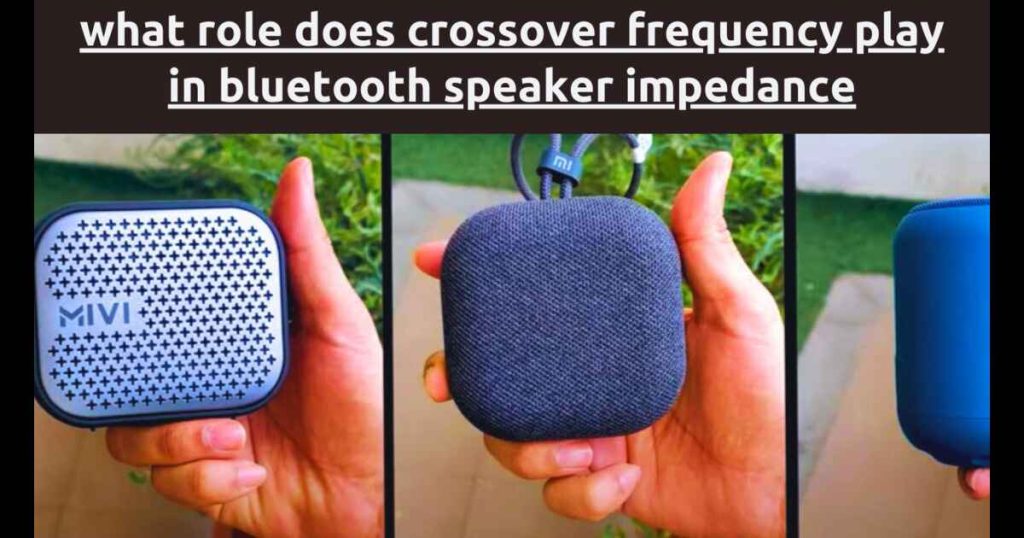
In the realm of audio engineering, the crossover frequency stands as a pivotal element shaping a speaker’s performance. When integrated into Bluetooth speakers, the crossover frequency interacts intricately with speaker impedance, influencing audio quality and overall sound reproduction.
In this comprehensive exploration, we unravel the nuanced role that crossover frequency plays in shaping Bluetooth speaker impedance and the resultant impact on audio fidelity.
Also read our comprehensive guide on impedance of Bluetooth speaker.
What role does crossover frequency play in Bluetooth speaker impedance?
Ever wondered how your cool Bluetooth speakers make all those amazing sounds? Well, let’s uncover a fantastic secret about something called “crossover frequency” and how it makes our speakers extra special.
It’s like a secret recipe that decides which sounds go where in our music. Join me on this adventure to explore how this “crossover frequency” thingamajig plays a big role in making our speakers sound super awesome!
Exploring Harmony: Unveiling the Connection Between Crossover Frequency and Speaker Impedance
Delving into the realm of audio intricacies, ‘Understanding Crossover Frequency and Speaker Impedance’ unravels the synergy between two key elements shaping our speaker’s performance. Crossover frequency, like a maestro orchestrating a symphony, divides the sound frequencies among different speaker components, such as tweeters and woofers. Meanwhile, speaker impedance defines the electrical resistance these components offer to the amplifier’s current.
By exploring this relationship, we’ll uncover how the interplay between crossover frequency and speaker impedance crafts the musical balance and fidelity of our audio experience, adding depth and richness to the sound we love.
Defining Crossover Frequency
Crossover frequency delineates the point where a speaker’s frequency response divides between different driver units, such as tweeters and woofers, ensuring optimal frequency reproduction for each driver.
Impedance in Bluetooth Speakers
Speaker impedance, measured in ohms, denotes the resistance offered by a speaker to the amplifier’s electrical current, influencing power consumption and audio output.
Harmonizing Sound Delivery: Exploring the Interplay of Crossover Frequency and Impedance
The interplay between crossover frequency and speaker impedance intricately shapes the way our speakers produce sound. Crossover frequency acts as a musical traffic controller, directing different frequencies to specific speaker components, while impedance determines how these components interact with the amplifier’s electrical current.
Understanding this interplay illuminates how the collaboration between crossover frequency and impedance influences our speaker’s performance, ensuring a balanced and harmonious audio output across various frequencies.
Driver Integration and Impedance
Crossover networks directing frequencies to specific drivers affect impedance, as different drivers might exhibit varying impedance characteristics at their designated frequencies.
Impedance Variations Across Frequency Bands
The crossover design can lead to impedance fluctuations across different frequency bands, influencing the speaker’s overall impedance curve and performance.
Influencing Sound Excellence: Understanding Impedance’s Impact on Audio Fidelity and Performance
Impedance plays a crucial role in sculpting the quality of sound and overall performance in our audio systems. This key element significantly influences how faithfully our speakers reproduce sound, affecting clarity, detail, and overall audio quality. By exploring the impact of impedance on audio fidelity and performance, we unravel the pivotal role this factor plays in delivering a rich and immersive listening experience, ensuring that every note resonates with precision and depth.
Frequency Response Alignment
A well-designed crossover aligns frequency responses of drivers, contributing to a cohesive and balanced sound output, optimizing audio fidelity.
Impedance Matching and Amplifier Compatibility
Efficient crossover designs ensure impedance matching across frequency bands, aiding amplifier compatibility and preventing impedance-related issues.
Real-World Applications: Navigating Impedance Practicalities and Considerations
Understanding the practical implications and considerations related to impedance opens the door to optimizing our audio experiences. Exploring how impedance affects our speaker systems in real-world scenarios provides valuable insights into selecting the right equipment, optimizing settings, and adapting to diverse environments.
By delving into these practical implications and considerations, we empower ourselves to make informed decisions that maximize our audio setups for an enhanced and tailored listening journey.
Tailoring Audio Preferences
Understanding crossover frequency allows users to select Bluetooth speakers with crossover designs aligning with their audio preferences and usage scenarios.
Manufacturer and Design Influences
Diverse manufacturer approaches to crossover design and implementation influence impedance characteristics, contributing to varied audio experiences.
Conclusion:
In the symphony of Bluetooth speaker design, crossover frequency emerges as a conductor harmonizing speaker performance. Its interaction with speaker impedance orchestrates the frequency response, driver integration, and audio fidelity. Understanding this interplay empowers users to select Bluetooth speakers that optimize impedance across frequency bands, delivering a harmonious audio experience tailored to individual preferences and nuances of speaker design.
